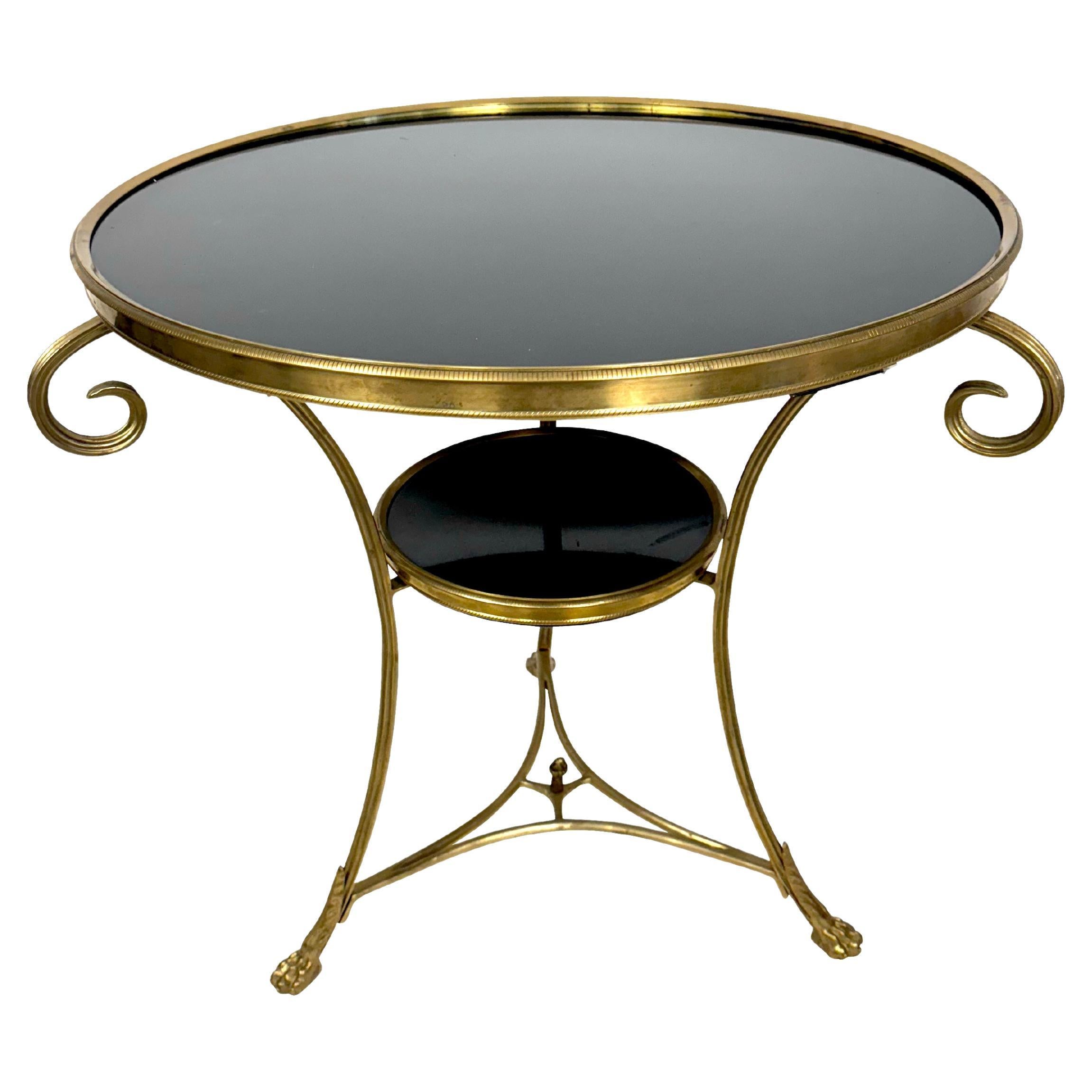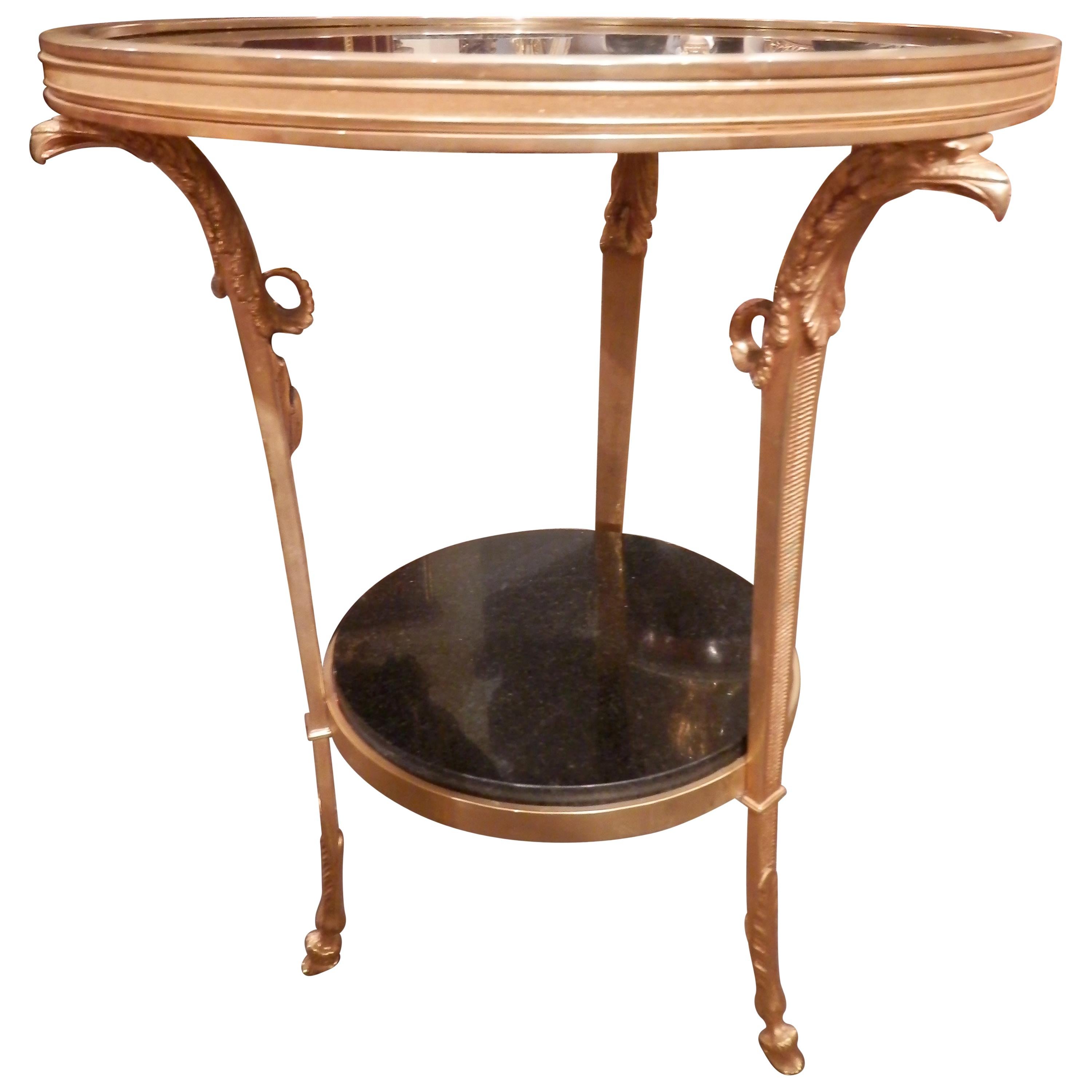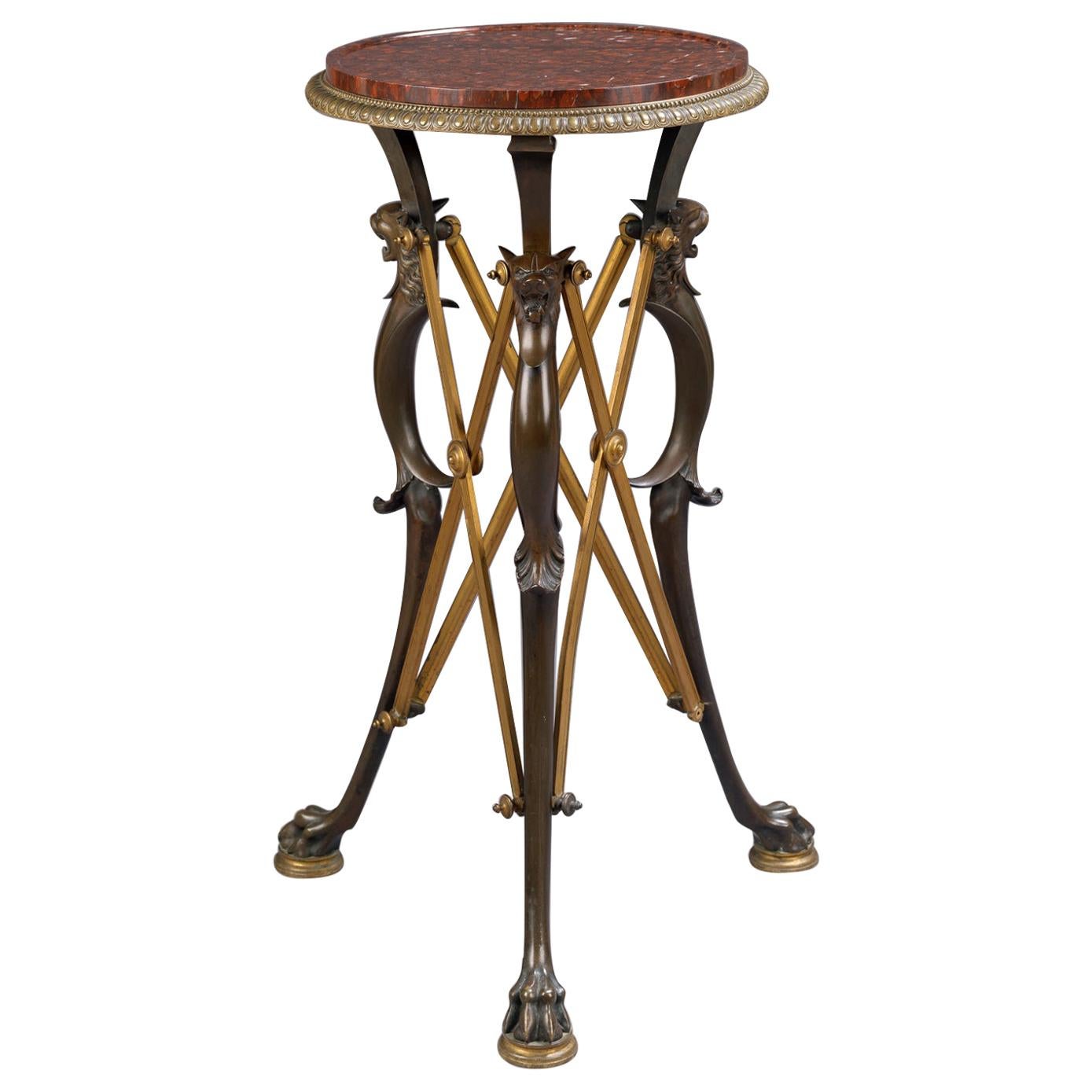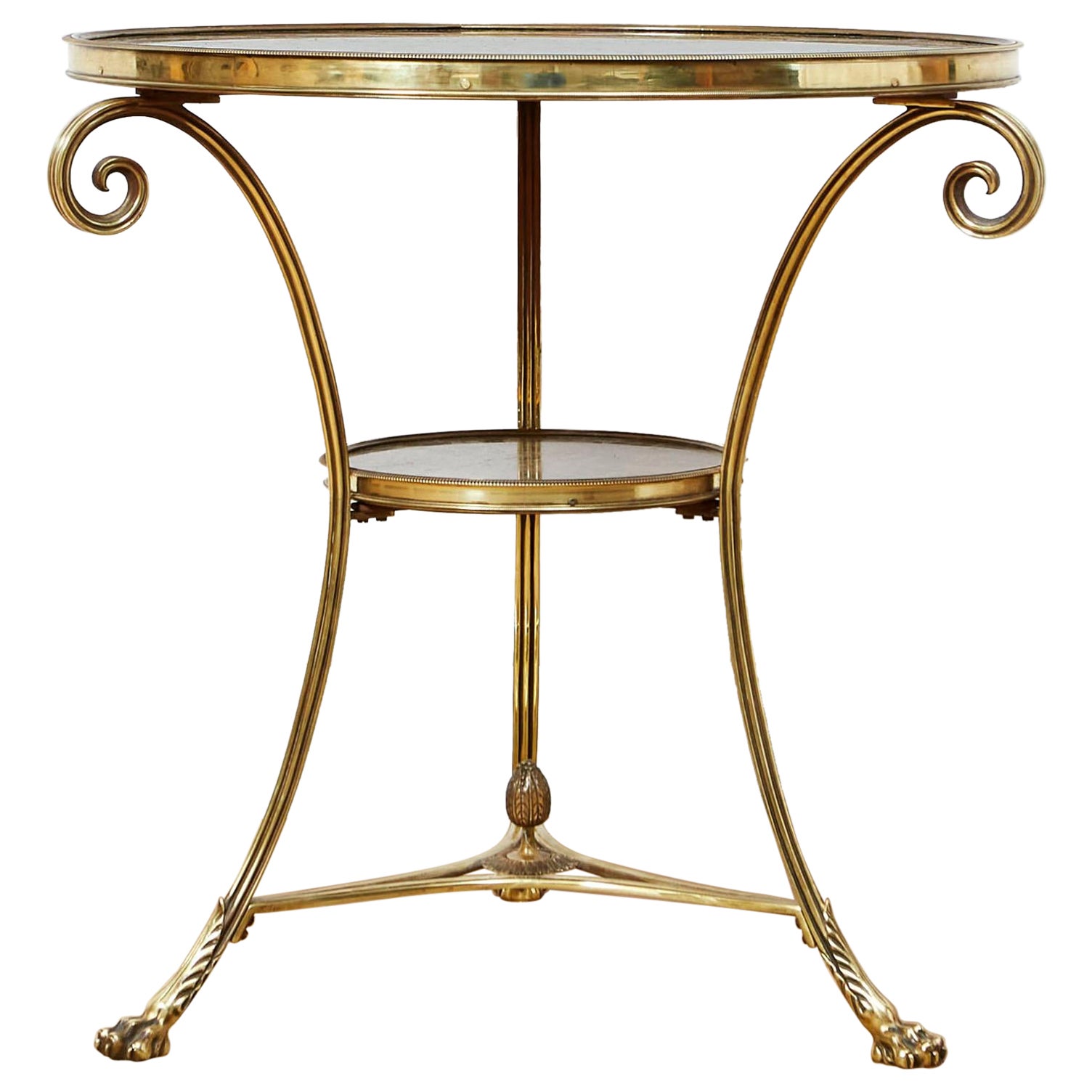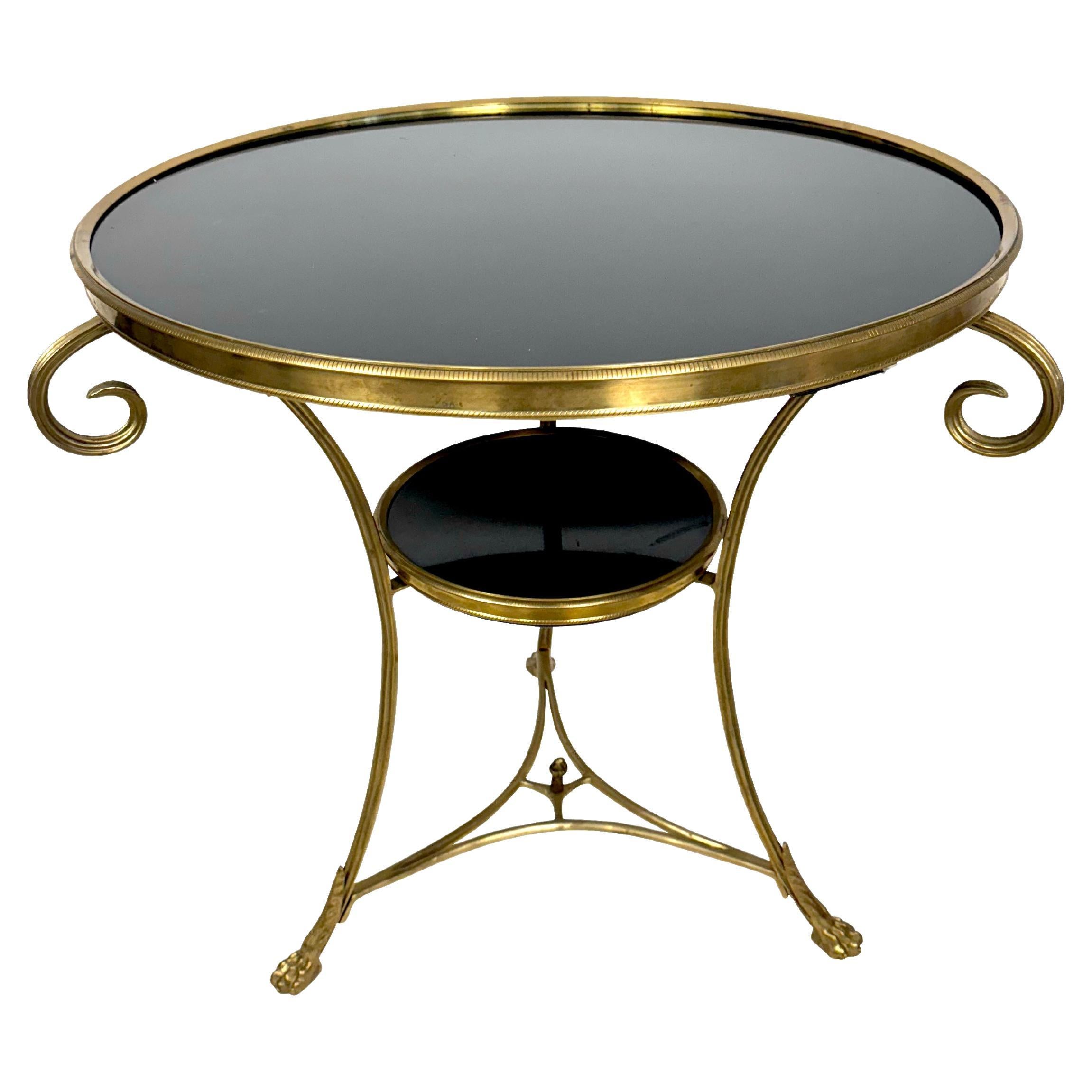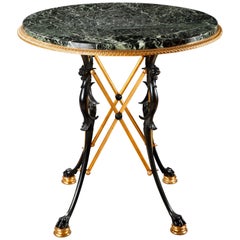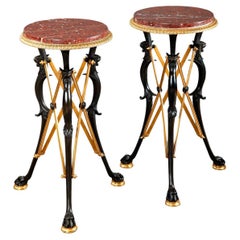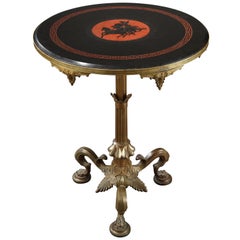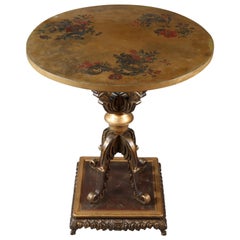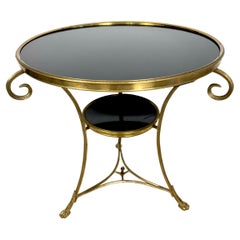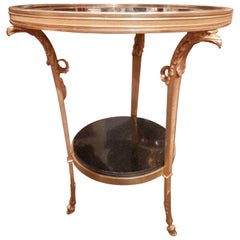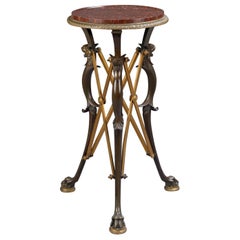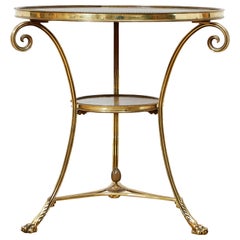Items Similar to Onyx and Bronze Neo-Greek Gueridon Att. to Barbedienne and Sevin, France, c.1880
Want more images or videos?
Request additional images or videos from the seller
1 of 9
Onyx and Bronze Neo-Greek Gueridon Att. to Barbedienne and Sevin, France, c.1880
$49,961.03
$62,451.2820% Off
£36,796.20
£45,995.2520% Off
€41,600
€52,00020% Off
CA$67,968.08
CA$84,960.1020% Off
A$75,527.53
A$94,409.4220% Off
CHF 39,577.23
CHF 49,471.5320% Off
MX$926,210.54
MX$1,157,763.1820% Off
NOK 504,784.48
NOK 630,980.6020% Off
SEK 474,882.71
SEK 593,603.3820% Off
DKK 316,694.41
DKK 395,868.0120% Off
Shipping
Retrieving quote...The 1stDibs Promise:
Authenticity Guarantee,
Money-Back Guarantee,
24-Hour Cancellation
About the Item
Gueridon made in silvered and gilded bronze, composed of four claw feet decorated with lion’s head held together by crossed bars in gilded bronze. It is surmounted by a large onyx top surrounded by a frieze of ovals and beads.
The feet of these gueridons adopt a sleek design and are adorned with claws and lion heads. This model is well known in the Barbedienne Company production and it has been reused many times by his workshop. This gueridon shows how the Barbedienne Company offered a range of furniture from the designs of its decorator Louis-Constant Sévin. He designed this model of gueridon few time after he joined the Barbedienne Company in 1855 and this model can be seen on different interior decorations of the Second Empire.
1/ A tripod gueridon, a little bit higher, with feet like these ones can be seen on a picture showing the atrium of the Pompeiian house built for Prince Napoleon. Most of the Ancient style furniture was made by Charles Rossigneux (1818-1908) but this gueridon shows that the Barbedienne Company took also part to this work.
2/ A picture of the Emperor’s study at Saint-Cloud Castle demonstrates that a gueridon of the same type took place in it ; it illustrates the success of this model in the imperial family.
Some years later the Gazette des Beaux-Arts published an engraving depicting a gueridon exhibited at the 1889 Universal Exhibition. The engraving shows a gilt bronze plate resting on a tripod having identical feet and it reveals the longevity of this model inside the Barbedienne Company production. The caption mentions “Bronze plate designed by Mr Levillain and made by Mr Barbedienne (1889 Universal Exhibition)”.
Louis-Constant Sévin (1821-1888) : he was first trained to design and sculpture with the sculptor Antoine-André Marneuf (1796-1865). In 1839 he went into partnership with two sculptors, Phénix and Joyau, and he created designs for famous goldsmiths such as Denière, Froment-Meurice and Morel. He fled to London during the 1848 Revolution where he worked at Morel, with whom he exhibited art works at the 1851 Universal Exhibition. Back to France he took part to the 1855 Universal Exhibition by creating designs to the Limoges porcelain makers Jouhanneaud and Dubois. Since then he worked as head decorator at Ferdinand Barbedienne’s Company. He produced a lot of works : he designed the bronze decoration for the Paiva’s Hotel (on the Champs-Elysées avenue) and created models for Ferdinand Barbedienne. He participated in different exhibitions and was awarded at the 1862 London Universal Exhibition for the artistical excellence of the furniture items he designed and which are exhibited by Barbedienne. He also received a Gold Medal as collaborator at the 1863 Central Union of Decorative Arts Exhibition.
Ferdinand Barbedienne (1810-1892) : he created and headed at n°30 boulevard Poissonnière in Paris one of the most famous 19th century artistic bronze casting companies. He owed his reputation to his bronze casting of Ancient and modern sculptures, which subjects came from the greatest European museums, but also to his original bronze works designed in his workshop and reserved for furniture and decoration. In addition to his own production, Barbedienne worked for renowned sculptors such as Barrias, Bosio, Clésinger or Carrier-Belleuse. Awarded with two Council Medals at the 1851 London Universal Exhibition, the Barbedienne Company won at the 1855 Paris Universal Exhibition a medal of honor and eleven cooperator's medals for the work of his co-workers, designers and chasers. The success of the Barbedienne Company at the diverse international exhibitions earned it several official commissions, as providing ornamental bronze for the Pompeiian house of Prince Napoleon, about 1860, avenue Montaigne in Paris. At the 1867 Universal Exhibition in his capacity as member of and speaker for the Jury, he was non-contestant, but exhibited nevertheless with great success cloisonné and champlevé enameled pieces. Barbedienne was made an Officer of the Légion d'Honneur in 1867 and Commander in 1878 when he was compared with “a prince of industry and the king of bronze casting”. His glory did not decline with the passage of the time for at the Universal Exhibition of 1889 the critics thanked Barbedienne for the example he set for other bronze-casters by the perfection of his bronzes.
- Attributed to:Louis-Constant Sevin (Designer)Ferdinand Barbedienne (Maker)
- Dimensions:Height: 30.32 in (77 cm)Diameter: 37.41 in (95 cm)
- Style:Greek Revival (In the Style Of)
- Materials and Techniques:
- Place of Origin:
- Period:
- Date of Manufacture:circa 1880
- Condition:Wear consistent with age and use.
- Seller Location:PARIS, FR
- Reference Number:1stDibs: LU3860328947682
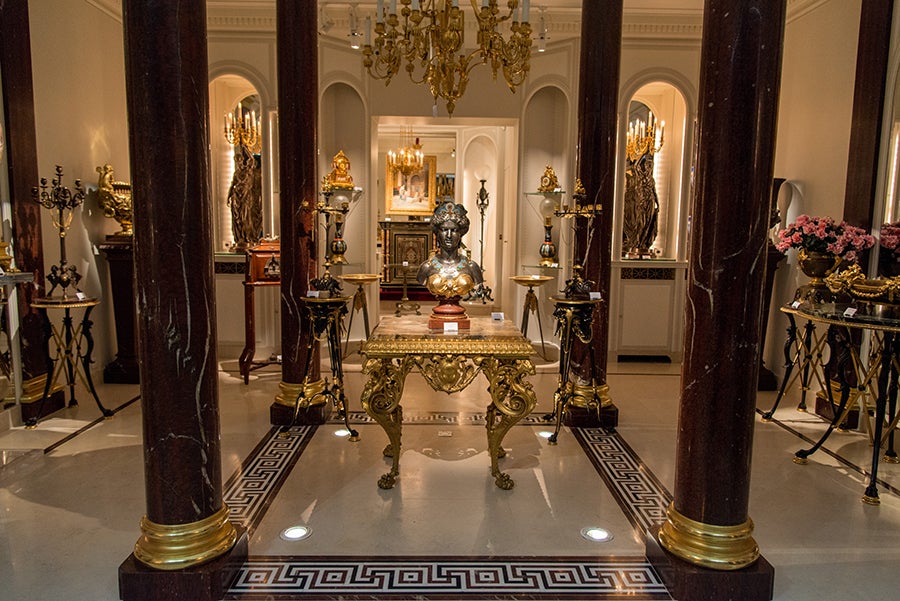
About the Seller
4.9
Vetted Professional Seller
Every seller passes strict standards for authenticity and reliability
Established in 1997
1stDibs seller since 2018
87 sales on 1stDibs
Typical response time: 1 hour
Associations
International Confederation of Art and Antique Dealers' Associations
- ShippingRetrieving quote...Shipping from: Saint Ouen, France
- Return Policy
Authenticity Guarantee
In the unlikely event there’s an issue with an item’s authenticity, contact us within 1 year for a full refund. DetailsMoney-Back Guarantee
If your item is not as described, is damaged in transit, or does not arrive, contact us within 7 days for a full refund. Details24-Hour Cancellation
You have a 24-hour grace period in which to reconsider your purchase, with no questions asked.Vetted Professional Sellers
Our world-class sellers must adhere to strict standards for service and quality, maintaining the integrity of our listings.Price-Match Guarantee
If you find that a seller listed the same item for a lower price elsewhere, we’ll match it.Trusted Global Delivery
Our best-in-class carrier network provides specialized shipping options worldwide, including custom delivery.More From This Seller
View AllNeo-Greek Gueridon Attributed to F. Barbedienne, France, Circa 1880
By Louis-Constant Sevin, Ferdinand Barbedienne
Located in PARIS, FR
A similar model was exposed at the 1889 Paris Universal Exhibition ( see picture attached)
Patinated and gilded bronze gueridon with four paw feet joined by X-shaped stems, attributed to Sévin and Barbedienne. Round green marble top mounted with a bronze rim adorned with oves and pearls motif.
Born in 1821 and dead in Paris in 1888, Louis-Constant Sévin was apprenticed to the parisian sculptor Marneuf. In 1839, he joined the sculptor-modelors Phénix and Joyau, as designer, and designed silver-smith’s objects for famous firms like Denière, Froment-Meurice, Morel and Duponchel. During the Revolution in 1848, C. Sévin joined Morel in London, as workshop manager and designed pieces that Morel exhibited in 1851. Back in France in 1851, C. Sévin went to Limoges and designed models for the porcelain factories of Jouhanneaud and Dubois of which many pieces were exhibited at the Universal Exhibition in 1855. From this date on, he worked for Ferdinand Barbedienne as sculptor-ornemanist until the end of his life. Sévin’s works are considerable, he designed furniture bronzes for the « hôtel de La Païva ». At the London Exhibition in 1862, he was awarded a medal « pour l’excellence artistique des meubles qu’il a dessinés et qui sont exposés par Barbedienne » : for the artistic excellence of the furniture he designed and which is exhibited by F. Barbedienne. He won a second class medal at the Union centrale des Arts décoratifs Exhibition in 1863 and was awarded a gold medal as « cooperator ». F. Barbedienne said that posterity would remember Sévin’s compositions. The most extraordinary object designed by C. Sévin for F. Barbedienne, was a Renaissance style gilded bronze monumental clock...
Category
Antique 1880s French Greek Revival Center Tables
Materials
Marble, Bronze
Pair of Neo-Greek Gueridons Attr. to L.C Sevin & F. Barbedienne, France, c. 1880
By Louis-Constant Sevin, Ferdinand Barbedienne
Located in PARIS, FR
Pair of patinated and gilded bronze high guéridon attributed to L.C Sevin and F. Barbedienne, with for each of them, three paw feet joined by X shaped stretche...
Category
Antique 1880s French Greek Revival Gueridon
Materials
Griotte Marble, Bronze
Neo-Pompeian Gueridon Attributed to F. Barbedienne, France, circa 1860
By Ferdinand Barbedienne
Located in PARIS, FR
A tripod gueridon in gilded bronze attributed to F. Barbedienne, decorated with palm-leaves and standing on lion’s feet. The black marble top is decorated with an antique chariot...
Category
Antique 1860s French Gueridon
Materials
Marble, Bronze
Aesthetic Movement Gueridon, England, Circa 1860
Located in PARIS, FR
A Japanese style lacquered table consisting of a circular top adorned with a gold nuagé lacquered decor and with red exotic flowers and scrolled foliage. The top is supported by four...
Category
Antique 1860s English Aesthetic Movement Gueridon
Materials
Lacquer
Pair of Neo-Greek Pedestals, attributed to G.Servant, France, Circa 1880
By Georges Emile Henri Servant
Located in PARIS, FR
Pair of patinated and gilded bronze turntable pedestals with for each of them, three paw feet, headed by stylized lion muzzles, ornated with beaded chains and joined by a fine foliate stretcher. The belt is adorned by a banded frieze cast in low-relief representing an ancient scene : “The Battle of the Lapithes and the Centaurs”.
These pedestals can be associated with the "Vases de Bacchus", presented by G. Servant at the 1867 Exposition Universelle, on which the similar ornamentation is applied.
(Reproduced in « Merveilles de l'Exposition Universelle de 1867 », Jules Mesnard, p°167)
Biography :
Georges Emile Henri Servant...
Category
Antique 1880s French Greek Revival Pedestals
Materials
Bronze
Pair of Neo-Pompeian Gueridons Malachite top , by H. Picard, France, c. 1865
By Henri Picard
Located in PARIS, FR
A similar model was exhibited at the 1889 Paris Universal Exhibition.
Rare pair of round table made of patinated and gilded bronze with a top veneered with malachite and circled with bronze mounts adorned with ovum and beads. They stands on three patinated bronze feet with lion heads and paws, linked with gilded bronze X braces.
Related Works:
The feet of these gueridons adopt a sleek design and are adorned with claws and lion heads. Inspired by a well-known model in the Barbedienne Company production and it has been reused many times by his workshop. These gueridons shows how the Barbedienne Company offered a range of furniture from the designs of its decorator Louis-Constant Sévin. He designed this model of gueridon few time after he joined the Barbedienne Company in 1855 and this model can be seen on different interior decorations of the Second Empire.
A tripod gueridon with feet like these ones can be seen on a picture showing the cold room of the Pompeiian house built for Prince Napoleon. (see picture attached, photograph by Laplanche J et Cie, between 1860-1866, Musée Carnavalet, Paris, PH15305). Most of the Ancient style furniture was made by Charles Rossigneux (1818-1908) but this gueridon shows that the Barbedienne Company took also part to this work.
Biography:
Henri Picard was established in Paris, 6 rue Jarente from 1831 to 1839 and then 10 rue de la Perle from 1840 to 1864. He worked on the Emperor Napoleon III’s apartments gilding at the Louvre Palace. His production was in a rich and fine style, like a Japanese style inkwell, or his Pompeian style dining table centerpieces...
Category
Antique Mid-19th Century French Greek Revival Gueridon
Materials
Malachite, Bronze
You May Also Like
19th Century French Brass and Black Marble Gueridon Table
By Maison Charles-Jansen
Located in Essex, MA
A fine quality French Louis XVI-style brass round Gueridon end table with 3 legs supporting an inset black marble top and shelf with a bottom stretcher. Dimensions:30 inches I diamet...
Category
Antique 19th Century French Neoclassical Gueridon
Materials
Marble, Brass
Fine 19th Century French Gilt Bronze and Marble Gueridon
Located in Dallas, TX
Very fine 19th century French gilt bronze and marble gueridon with gilt bronze eagles heads and pawed feet.
Category
Antique Late 19th Century French Empire Gueridon
Materials
Belgian Black Marble, Bronze
Neoclassical Patinated and Gilt-Bronze Gueridon with a Marble Top, circa 1890
By Ferdinand Barbedienne, Ferdinand Levillain
Located in Brighton, West Sussex
A fine neoclassical patinated and gilt bronze gueridon with a rouge griotte marble top, attributed to Barbedienne and Ferdinand Levillain.
French, circa 1890.
This striking g...
Category
Antique Late 19th Century French Neoclassical Gueridon
Materials
Marble, Bronze
Fine Late Nineteenth Century Brass and Marble Gueridon
By Jacob-Desmalter
Located in London, GB
A refined gueridon, after a design by Jacob-Desmalter with brass tripod base, the uprights with scrolls to the top and terminating in paw feet, the top and second tier with original ...
Category
Antique Late 19th Century French Empire Revival Gueridon
Materials
Marble, Brass
French Gilt Two Tier Bronze Gueridon Table with Black Marble Top
By Maison Jansen
Located in Essex, MA
A fine quality French gilt bronze and black marble gueridon table with impressive casting to lower acorn finial, hair paw feet on casters. Directoire or Regency style French guerido...
Category
20th Century French Neoclassical Gueridon
Materials
Marble, Brass
Fine Late Nineteenth Century Brass and Marble Gueridon
By Jacob-Desmalter
Located in London, GB
A refined gueridon, after a design by Jacob-Desmalter with brass tripod base, the uprights with scrolls to the top and terminating in paw feet, the top and second tier with original ...
Category
Antique Late 19th Century French Empire Revival Gueridon
Materials
Marble, Brass
More Ways To Browse
Large Bronze Cross
Antique Imperial Tables
Lions Head Dining Table
French Claw Table
Second Empire Table
Antique Imperial Furniture Table
Ancient Silver Cross
French Lion Head Tables
Plate 1865
Empire Oval Table
Gold Claw Table
Ancient Greek Bead
Onyx Cross
Porcelain D Art Limoges France
Ancient Greek Cross
Decorative Plates Set Of 2 Large
Speaker Table
Lion Head And Claws

